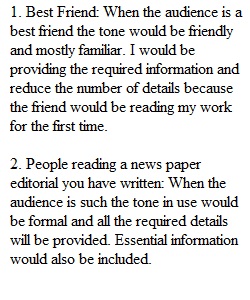


Q Overview: The short response activities in the webtext throughout this course are designed to show your understanding of key concepts as you engage with course content. Prompt: During the fourth week of the course, you will respond to several questions in the webtext as you complete each learning block. At the end of Module Four, you will review your answers to these questions and ensure that you have responded to each question. It is important that you answer each question; otherwise, the words “[no response]” will appear in brackets when you submit the assignment. The questions and their original locations in the webtext are listed in this table in case you want to refer back to the reading as you edit, but you can edit your responses to all the questions directly in Module Four: Communicating Historical Ideas, continued, learning block 4-4 (page 2) in the webtext, before exporting to Word for submission to your instructor in your learning environment. Module Four: Communicating Historical Ideas, continued, Learning Block 4-2 (pages 2–3): • Question 1: Consider the examples of different audiences below. For each one, describe how you would adjust your writing for that particular audience 1. Your best friend 2. People reading a newspaper editorial you have written 3. Your professor 4. The audience at a conference where you are presenting • Question 2: Consider how your audience might influence the information you include in a historical analysis essay about the women’s suffrage movement. What audience would be most interested in reading about the women’s movement? How would you tailor your presentation to that audience? What message would be most appropriate for this audience? • Question 3: Let’s say the intended audience for your historical analysis essay about the legal battle for women’s suffrage is a group of civil rights lawyers. How would you explain the legal background of the Constitution and the Nineteenth Amendment? How would this approach compare with and contrast to an audience of high school students? Module Four: Communicating Historical Ideas, continued, Learning Block 4-3 (pages 1–2): • Question 4: Was President Kennedy’s decision to support the Equal Rights Amendment a necessary cause for the amendment’s passage by Congress? • Question 5: Was the social tumult of the 1960s a necessary cause of the women’s liberation movement? • Question 6: Simone de Beauvoir was the intellectual founder of the women’s liberation movement. Tailor this thesis statement into a message suitable for an audience of high-school history students. • Question 7: The women’s movement’s focus on issues related to sexual freedom, including reproductive rights, galvanized support among younger women but alienated many older, more conservative women. Tailor this message for an audience consisting of students in a women’s studies class.
View Related Questions